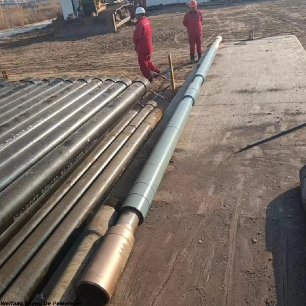A hydraulic jar is a specialized downhole tool that uses hydraulic pressure to deliver a sudden, controlled impact, helping drilling crews free stuck equipment and maintain smooth operations. It is a crucial component in the bottom hole assembly (BHA), designed to overcome common drilling challenges such as differential sticking, borehole instability, or debris blockage. Understanding how a hydraulic jar operates is essential for oilfield professionals because proper use not only improves efficiency but also prevents unnecessary tool damage. By learning the mechanism behind its operation, crews can better control impact energy, ensure safety, and extend the life of the equipment.
Basic Function of a Hydraulic Jar
A hydraulic jar's main role is to generate a high-energy jarring action downhole. This action is used to free stuck components in the drill string or other downhole tools without pulling the entire assembly to the surface. The jar achieves this by creating a delay in movement through hydraulic resistance, which allows energy to build up before being released suddenly.
In essence, it works like a hammer stroke deep inside the wellbore — only the hammer is activated by hydraulic pressure and is precisely controlled to avoid damaging sensitive equipment.
Working Principle
The hydraulic jar operates on the principle of hydraulic delay and release. When the driller applies tension or compression to the drill string, the internal mandrel of the jar begins to move relative to its outer housing. This movement is resisted by hydraulic fluid passing through a restricted flow path inside the jar.
Because the flow path is small, the hydraulic oil takes time to move, creating a delay. During this delay, energy builds up in the drill string like a stretched spring. When the hydraulic restriction is overcome, the mandrel moves rapidly, releasing the stored energy in a sharp jarring action.
Key points of the working principle:
Hydraulic Delay: Controls timing and prevents accidental premature impact.
Damping Effect: Hydraulic fluid cushions the motion, protecting components.
Impact Release: Sudden movement creates a shockwave strong enough to free stuck equipment.
Internal Mechanism Breakdown
The efficiency of a hydraulic jar lies in its internal design. The main components include:
Hydraulic Chamber
This sealed section contains high-grade hydraulic oil. The oil is responsible for the controlled delay and damping effect.
Flow Path and Metering System
The chamber includes calibrated ports or valves that regulate the flow of oil. By controlling this flow, the jar creates a predictable delay before impact.
Piston and Mandrel
The piston is connected to the mandrel and moves within the chamber. As tension or compression is applied, the piston forces oil through the restricted path.
Seals and Bearings
Special high-pressure seals keep the oil contained, while bearings ensure smooth relative motion between moving parts.
Preload and Delay Trigger
The jar must be preloaded by pulling or pushing the drill string to store energy. The delay trigger allows this load to build before releasing it as an impact.
This arrangement allows the hydraulic jar to operate under extreme downhole conditions, including high temperature, pressure, and abrasive drilling fluids.
Operation Steps in the Field
The proper use of a hydraulic jar in drilling operations requires following a well-coordinated sequence of steps to ensure safety, precision, and maximum efficiency:
Pre-Set Impact Direction
Before starting the jarring action, determine whether the required impact should be upward or downward, depending on the type and location of the obstruction. Choosing the correct direction prevents unnecessary strain on equipment and increases the likelihood of freeing the stuck component.
Apply Preload
Once the direction is set, apply the necessary tensile (pull) or compressive (push) force to the drill string. This stores potential energy in the system, which will be released during the jarring action.
Hydraulic Delay
Hold the applied load steady. During this stage, hydraulic oil flows slowly through a restricted passage inside the jar, creating a controlled delay. This delay allows the system to build up the required force for an effective impact.
Impact Release
When the hydraulic restriction is cleared, the mandrel inside the jar moves rapidly. This sudden movement delivers a strong blow against the anvil section of the jar, generating the required shock to loosen or free stuck equipment.
Resetting the Jar
After impact, gradually reduce the applied load. This allows the hydraulic mechanism to reset to its starting position, preparing the jar for another jarring cycle if needed.
By following these steps carefully, operators can achieve consistent and controlled impacts while minimizing the risk of overstressing the drill string or damaging other downhole tools.
Control of Impact Energy
One of the advantages of a hydraulic jar is the ability to control the amount of impact energy. This is influenced by several factors:
Applied Load
Increasing the tensile or compressive load before release produces a stronger impact.
Delay Time
Holding the load for a longer period allows more energy to accumulate in the drill string.
Hydraulic Oil Properties
The viscosity of the oil affects the delay time and damping effect. Higher viscosity slows the fluid movement, lengthening the delay.
Environmental Conditions
Well depth, temperature, and pressure can all change the oil's viscosity and, in turn, affect jar performance.
By adjusting these parameters, drillers can fine-tune the jar's performance for different downhole challenges.
Maintenance and Troubleshooting
Even the best hydraulic jars require periodic maintenance to ensure reliable performance. Common issues include:
Hydraulic Oil Leaks
Caused by worn seals or damaged housings. This reduces delay control and impact strength.
Seal Failure
High temperatures and abrasive drilling fluids can degrade seals, leading to oil loss.
Delayed Trigger Malfunction
If the delay time becomes too short or too long, it may be due to oil contamination, incorrect viscosity, or damage to the metering system.
Preventive maintenance tips:
Regularly inspect and replace seals.
Use manufacturer-approved hydraulic oil.
Check for scoring or wear on mandrels and barrels.
Test the jar's delay time before deployment.
A proactive maintenance plan extends service life and minimizes unplanned downtime.
Safety Considerations During Operation
Hydraulic jars store and release significant amounts of energy, so safety is critical:
Pre-Operation Checks
Verify that the jar is correctly assembled, filled with clean hydraulic oil, and free of damage.
Controlled Loading
Apply load gradually to avoid shock loading the drill string or prematurely triggering the jar.
Avoid Overloading
Excessive force can damage the jar, drill string, or other downhole tools.
Clear Communication
Ensure all crew members are aware when jarring is about to occur to prevent accidents on the rig floor.
Proper training and strict adherence to safety procedures reduce risks and improve operational efficiency.
Conclusion
The hydraulic jar is a precision-engineered tool that applies hydraulic delay technology to deliver controlled, high-energy impacts in drilling operations. Understanding its operation — from the hydraulic chamber to the delay release — enables operators to make informed decisions, adjust impact energy effectively, and maintain safety in challenging well conditions. Its ability to free stuck equipment quickly and reliably makes it indispensable for both drilling and fishing applications.
For dependable hydraulic jar solutions, Weifang Shengde Petroleum Machinery Manufacturing Co., Ltd. offers expertly designed products built for durability, precision, and adaptability in the toughest environments. Backed by years of industry experience, the company provides high-quality tools and technical support to meet diverse operational needs. To learn more or discuss tailored solutions for your drilling projects, visit their website or contact their professional team today.















